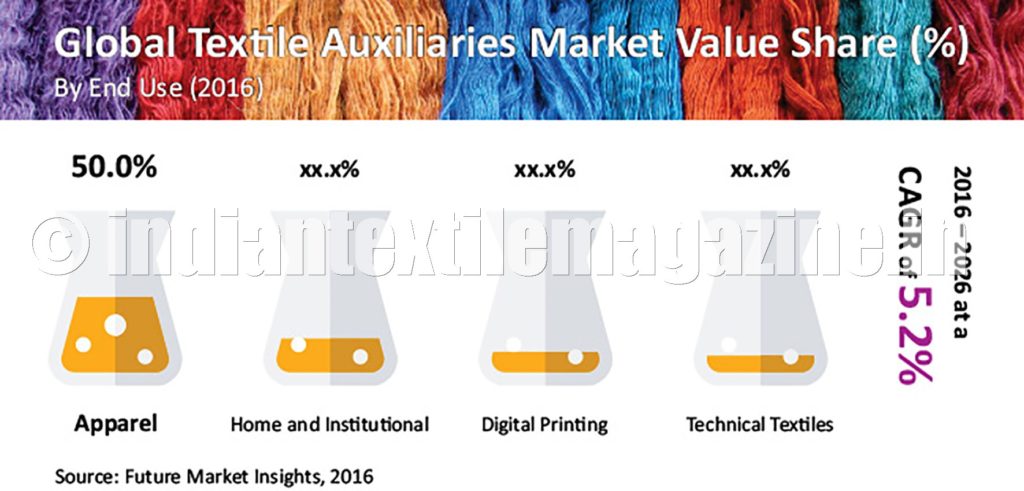The global market for textile auxiliaries is estimated at nearly $7,770 million in 2017. By 2026, the market is expected to be valued at nearly $12,400 million, registering a CAGR of 5.2 per cent in terms of value over the forecast period. The global market is expected to witness an absolute dollar opportunity of nearly $4,400 million between 2016 and 2026. Growing applications of textile auxiliaries in the construction sector are a good sign for this market.
Technical textiles impart strength as well as resistance and protection from various pollutants and environmental factors. Growing infrastructural development as well as rapid urbanisation, especially in BRIC countries, is driving demand for Buildtex, a technical textile that is more durable and effective as compared to conventional textile materials. It is majorly used in construction and architectural applications such as faced foundation, insulation (majorly in Russia) and concrete reinforcement. The growing use of technical textiles is set to boost the market for textile auxiliaries during the assessment period.
Increased government and per capita spending on healthcare is set to boost the market for textile auxiliaries.
Meditech textiles consist of materials that are used in hygiene, health as well as in surgical applications. The global textile auxiliaries market is expected to witness increasing contribution in value as well as volume share by the Meditech segment over the forecast period. This is primarily due to rising government and per capita spending on healthcare worldwide. Growing awareness about health and hygiene in emerging economies is fuelling demand for healthcare products such as baby diapers and sanitary napkins that use technical textiles.
The growing focus on innovation and R&D provides a fillip to the textile auxiliaries market. The major textile auxiliaries companies have set up their research and development facilities in several regions, including Asia Pacific, North America, and Western Europe. The emphasis is on developing chemicals that are eco-friendly, energy efficient and at the same time are cost effective. Moreover, efforts are focussed on developing multi-functional chemicals. This is set to expand the market for textile auxiliaries during the forecast period.
High pricing of finished products may hamper the revenue growth of textile auxiliaries. Natural textile auxiliaries are relatively expensive as compared to synthetic substitutes. This is due to the high costs associated with raw materials and operational costs and limited availability of natural textile auxiliaries. For instance, processes used in the extraction and manufacturing of natural textile auxiliaries are more capital intensive as compared to those used in synthetic textiles. Moreover, natural textile auxiliaries manufacturing needs technically trained workers to oversee the processes. These factors may hamper the growth of textile auxiliaries during the forecast period.
Asia has emerged as the hub for the global textile industry. The promising growth of the textile industry in turn drives the demand for textile chemicals, which form the most vital part of the textile manufacturing process imparting a variety of functional, aesthetic properties to the textiles, besides their use as processing chemicals. Increasing demand for textile auxiliaries is directly impacting the growth of the textile auxiliaries market. The textile chemicals market in Asia Pacific is set to witness robust growth during the forecast period. China and India are expected to spearhead the growth in demand for textile auxiliaries in the region.
The apparel segment is anticipated to register a significantly high CAGR during the forecast period. The apparel segment accounted for a significant market value share of 50 per cent in 2016. This segment is expected to dominate the global textile auxiliaries market over the forecast period. In terms of volume consumption, the digital printing segment is expected register a CAGR of 3.2 per cent over the forecast period.
Toxic waste production and stringent environmental regulations may inhibit the growth of the textile auxiliaries market. Man-made fibres such as polyester and synthetic materials are some of the major applications for textile auxiliaries. These are not easily bio-degradable and contain toxic substances. Also, significant material waste is produced during various stages of manufacture such as cutting and trimming. These pose a serious threat to environmental sustainability. Governments across the world have imposed environmental regulations and set up stringent quality standards for technical textile products. These regulations may hinder market growth of textile auxiliaries during the forecast period.
